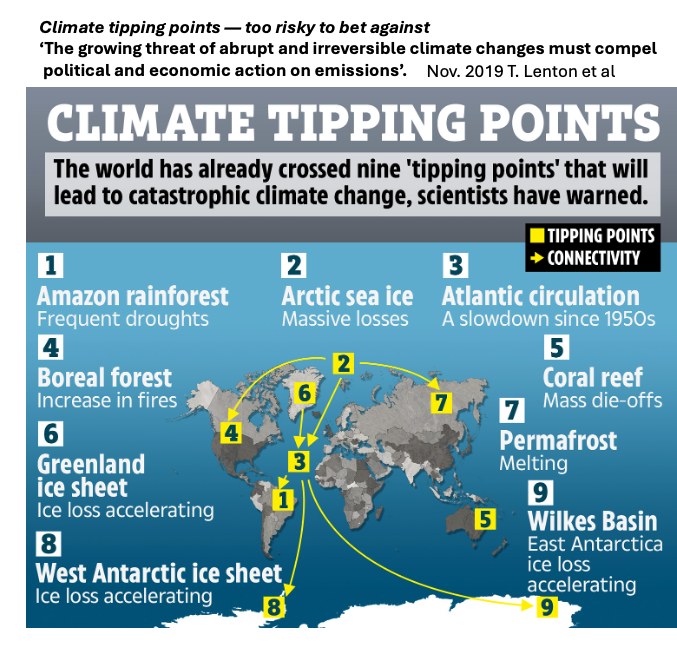Tipping Points
This is not new new science
Tipping elements in the Earth's climate system
Timothy M. Lenton et al PNAS Feb 2008
Tipping elements in the Earth's climate system
Timothy M. Lenton et al PNAS Feb 2008
What are tipping points? (Note: not new)
The term ‘‘tipping point’’ commonly refers to a critical threshold at which a tiny perturbation can qualitatively alter the state of a system (T. Lenton). This generally includes an abrupt irreversible climate system switch and an acceleration of change beyond the driving forcing (NAP 2011) (NRC 2011 Summary).
IPCC current definition is “a critical threshold beyond which a system reorganises, often abruptly and/or irreversibly”
The term ‘‘tipping point’’ commonly refers to a critical threshold at which a tiny perturbation can qualitatively alter the state of a system (T. Lenton). This generally includes an abrupt irreversible climate system switch and an acceleration of change beyond the driving forcing (NAP 2011) (NRC 2011 Summary).
IPCC current definition is “a critical threshold beyond which a system reorganises, often abruptly and/or irreversibly”
James Hansen on tipping points years ago lecture (2009).
"Here are several climate tipping points of special concern. Tipping points are “non-linear” phenomena, which means that they can reach a point at which rapid catastrophic change occurs.
Species extermination is also a non-linear problem. Today we are placing many species under multiple stresses, but one stress that is growing rapidly is the shifting of climate zones due to global warming. ... Because of interdependencies of species, the loss of key species can cause entire ecosystems to collapse.
Arctic methane. Methane is an especially powerful greenhouse gas. There are large amounts of methane presently locked up, frozen, in high latitude tundra and, especially, in ocean sediments on continental shelves. We know from Earth’s history that this frozen methane can be released suddenly by sufficient warming – thus this methane has the potential to greatly amplify human made
global warming, if that warming reaches a level, a tipping point, such that large volumes of frozen methane begin to melt."
It is intuitive that there won't be early warnings and even if there jt would far too late to stop or slow the the boosted warming.
A 2010 study on tipping points: Early warning and wishful thinking finds that they have very limited predictability. The worst tipping point would be an abrupt large increase in global temperature. This paper takes the ice core abrupt warming events and finds no early warning indicators.
Like James Hansen, Andrew Gliskson finds from the ice core distant past that the planet tends to warm abruptly and we have added too much GHG heat to the system for any security of avoiding tipping points. Trends and tipping point in the climate system: portents for the 21st century. Past and current trends in the atmosphere/ocean system Andrew Glikson Earth and Palaeoclimate science Australian National University.
The Australia government office for science published Dangerous Climate Change and Tipping Points with a list of potential tipping points:
• rapid melting of the Greenland Ice Sheet
• collapse of the West Antarctic Ice Sheet
• abrupt retreat of Arctic summer sea-ice
• shut-down of the over-turning circulation in the Atlantic Ocean – also known as the ‘Atlantic Meridional Overturning Circulation’ (AMOC) or the Atlantic Thermohaline Circulation
• dieback of the Amazon rainforest
• rapid release of methane from permafrost or ‘methane hydrates’. Methane hydrates are structures consisting of methane locked into a water-ice lattice. They are sometimes referred to as ‘methane clathrates’. They occur in deep ocean sediments and under permafrost (frozen ground)
• sudden changes to marine ecosystems resulting from ocean acidification
What is recognized but has been given too little attention is the possibility of self reinforcing +ve feedbacks or multiple cascading catastrophes reaching planetary tipping levels for a megacatastrophe. A Harvard discussion paper Responding to Threats of Climate Change Mega- Catastrophes does consider and how to respond to such a risk. This addresses the important question of rapid abatement and geo-engineering.
The ultimate tipping point
'Accelerating stress levels, increasing frequencies of extreme events and strengthening intersystem connections suggest that conventional modelling approaches based on incremental changes in a single stress may provide poor estimates of the impact of climate and human activities on ecosystems.
Collapses occur sooner under increasing levels of primary stress but additional stresses and/or the inclusion of noise in all four models bring the collapses substantially closer to today'
Earlier collapse of Anthropocene ecosystems driven by multiple faster and noisier drivers, Simon Willcock et al 22 June 2023
"Here are several climate tipping points of special concern. Tipping points are “non-linear” phenomena, which means that they can reach a point at which rapid catastrophic change occurs.
Species extermination is also a non-linear problem. Today we are placing many species under multiple stresses, but one stress that is growing rapidly is the shifting of climate zones due to global warming. ... Because of interdependencies of species, the loss of key species can cause entire ecosystems to collapse.
Arctic methane. Methane is an especially powerful greenhouse gas. There are large amounts of methane presently locked up, frozen, in high latitude tundra and, especially, in ocean sediments on continental shelves. We know from Earth’s history that this frozen methane can be released suddenly by sufficient warming – thus this methane has the potential to greatly amplify human made
global warming, if that warming reaches a level, a tipping point, such that large volumes of frozen methane begin to melt."
It is intuitive that there won't be early warnings and even if there jt would far too late to stop or slow the the boosted warming.
A 2010 study on tipping points: Early warning and wishful thinking finds that they have very limited predictability. The worst tipping point would be an abrupt large increase in global temperature. This paper takes the ice core abrupt warming events and finds no early warning indicators.
Like James Hansen, Andrew Gliskson finds from the ice core distant past that the planet tends to warm abruptly and we have added too much GHG heat to the system for any security of avoiding tipping points. Trends and tipping point in the climate system: portents for the 21st century. Past and current trends in the atmosphere/ocean system Andrew Glikson Earth and Palaeoclimate science Australian National University.
The Australia government office for science published Dangerous Climate Change and Tipping Points with a list of potential tipping points:
• rapid melting of the Greenland Ice Sheet
• collapse of the West Antarctic Ice Sheet
• abrupt retreat of Arctic summer sea-ice
• shut-down of the over-turning circulation in the Atlantic Ocean – also known as the ‘Atlantic Meridional Overturning Circulation’ (AMOC) or the Atlantic Thermohaline Circulation
• dieback of the Amazon rainforest
• rapid release of methane from permafrost or ‘methane hydrates’. Methane hydrates are structures consisting of methane locked into a water-ice lattice. They are sometimes referred to as ‘methane clathrates’. They occur in deep ocean sediments and under permafrost (frozen ground)
• sudden changes to marine ecosystems resulting from ocean acidification
What is recognized but has been given too little attention is the possibility of self reinforcing +ve feedbacks or multiple cascading catastrophes reaching planetary tipping levels for a megacatastrophe. A Harvard discussion paper Responding to Threats of Climate Change Mega- Catastrophes does consider and how to respond to such a risk. This addresses the important question of rapid abatement and geo-engineering.
The ultimate tipping point
'Accelerating stress levels, increasing frequencies of extreme events and strengthening intersystem connections suggest that conventional modelling approaches based on incremental changes in a single stress may provide poor estimates of the impact of climate and human activities on ecosystems.
Collapses occur sooner under increasing levels of primary stress but additional stresses and/or the inclusion of noise in all four models bring the collapses substantially closer to today'
Earlier collapse of Anthropocene ecosystems driven by multiple faster and noisier drivers, Simon Willcock et al 22 June 2023
'We show that the mean temperature of the warmest quarter (3-month period) passed the thermal maximum for photosynthesis during the past decade. At higher temperatures, respiration rates continue to rise in contrast to sharply declining rates of photosynthesis. Under business-as-usual emissions, this divergence elicits a near halving of the land sink strength by as early as 2040'.
How close are we to the temperature tipping point of the terrestrial biosphere? Katharyn A. Duffy et al, 3 Jan . 2021
How close are we to the temperature tipping point of the terrestrial biosphere? Katharyn A. Duffy et al, 3 Jan . 2021
'Localized ecological systems are known to shift abruptly and irreversibly from one state to another when they are forced across critical thresholds. Here we review evidence that the global ecosystem as a whole can react in the same way and is
approaching a planetary-scale critical transition as a result of human influence'.
Approaching a state shift in Earth’s biosphere, Anthony D Barnosky et al, Jan. 2012
As there are many enormous source potential tipping points and they have inter-reinforcing risks/impacts for a planetary catastrophe this alone argues for the development of the rapid planetary emergency response capacity. Clearly the IPCC 6th Assessment call for immedaite rapid global emissions decline is an imperative for suture survival.
Approaching a state shift in Earth’s biosphere, Anthony D Barnosky et al, Jan. 2012
As there are many enormous source potential tipping points and they have inter-reinforcing risks/impacts for a planetary catastrophe this alone argues for the development of the rapid planetary emergency response capacity. Clearly the IPCC 6th Assessment call for immedaite rapid global emissions decline is an imperative for suture survival.
The ultimate tipping point caused by industrial GHG global warming would be so-called 'runaway' global warming/ Hot house Earth in the science terms. This is a self accelerating multiple amplifying (mainly Arctic) feedback situation. Research published on 30 July 2013 suggests that this could happen.
21 March 2016. Nature. Risk of multiple interacting tipping points should encourage rapid CO2 emission reduction. Yongyang Cai, Tim M. Lenton, T. S. Lontzek
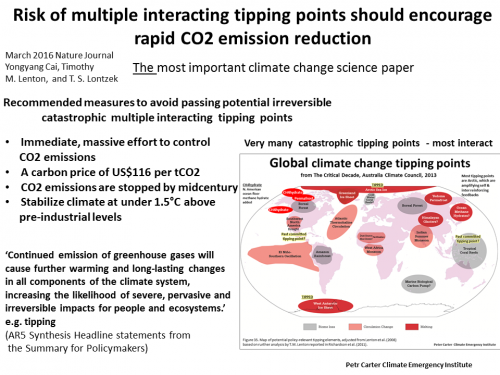
23 June 2017 Tipping points are real: Gradual changes in carbon dioxide levels can induce abrupt climate changes (abrupt extreme N.H. warming)
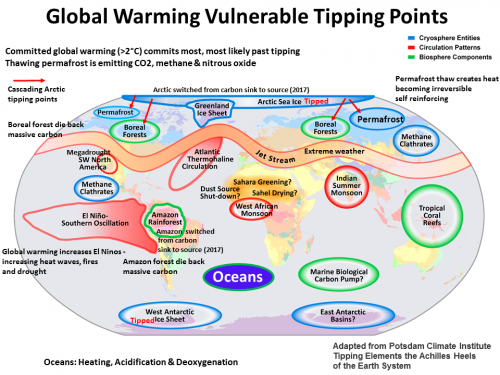
Climate tipping points —too risky to bet against, Nature, Nov 2019,
In our view, the evidence from tipping points alone suggests that we are in a state of planetary emergency...We argue that the intervention time left to prevent tipping could already have shrunk towards zero, ...In other words, warming must be limited to 1.5 °C.
This requires an emergency response."
This requires an emergency response."
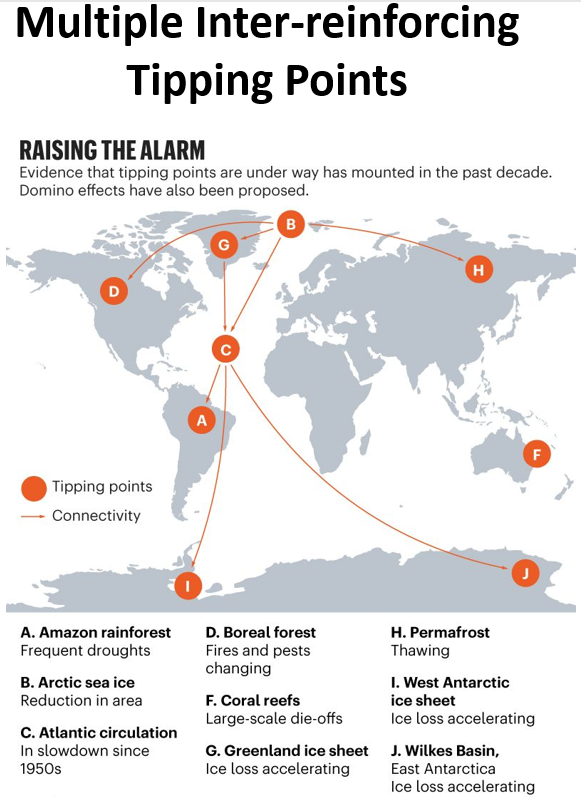
ClimateTippingPoints.info. Super site on tipping points co David McKay Paper below
Feb 10th 2020 Carbon Brief Article: 9 ‘tipping points’ that could be triggered by climate change
Exceeding 1.5°C global warming could trigger multiple climate tipping points
Youtube 2021 Expert Johan Rockström Explains Earth's Climate Tipping Points

Multiple large global warming feedbacks and tippimg ponts triggered at 2°C 2018 Trajectories of the Anthropocene 'hothouse Earth' paper
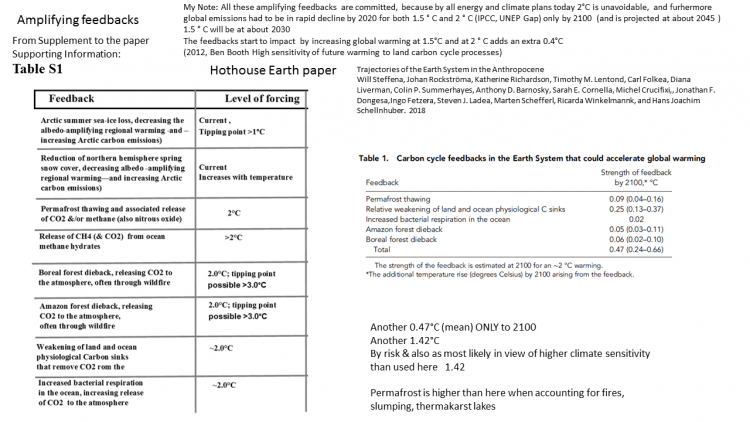




Climate Emergency Institute
Hothouse Earth Supplement-all triggered 2°C
Committed Global Warming Risks Triggering Multiple Climate Tipping Points, J. Abram et al, 6 Nov. 2023
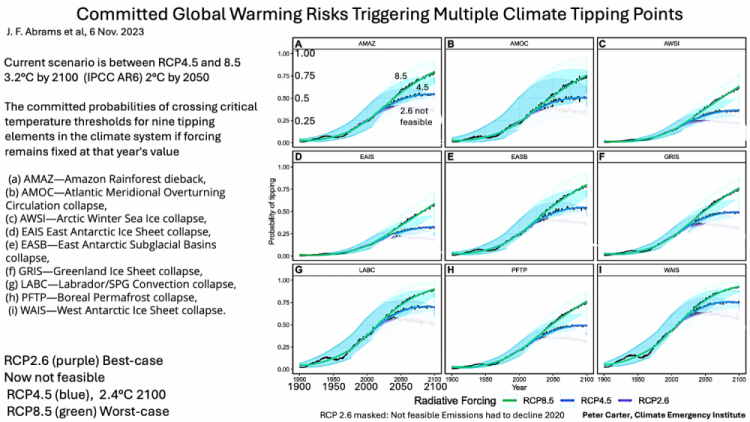
Largest tipping point project Global Tipping Points led by Tim Lenton 2023
IPCC AR6 tipping mentions
Abrupt responses and tipping points of the climate system, such as
Abrupt responses and tipping points of the climate system, such as
strongly increased Antarctic ice-sheet melt and forest dieback, cannot be ruled out
AR6 WG1. SPM
... hazards and cascading risks also trigger tipping points in sensitive ecosystems and in significantly and rapidly changing social-ecological systems impacted
AR6 WG1. SPM
... hazards and cascading risks also trigger tipping points in sensitive ecosystems and in significantly and rapidly changing social-ecological systems impacted
by ice melt, permafrost thaw and changing hydrology in polar regions
AR6 WG2 SPM
IPCC on Tipping Points
IPCC 6th Assessment has only scant mention of tipping ponts
IPCC projections are linear, there are no abrupt of non linear temperature increases.
The many enormous sources of amplifying feedbacks that involve tipping points are not accounted for in ICC model projections. This is still the case in the 6th Assessment, despite the fact that long ago it was recognised that the climate system is characterised by sudden long linear changes.
IPCC 6th Assessment has only scant mention of tipping ponts
IPCC projections are linear, there are no abrupt of non linear temperature increases.
The many enormous sources of amplifying feedbacks that involve tipping points are not accounted for in ICC model projections. This is still the case in the 6th Assessment, despite the fact that long ago it was recognised that the climate system is characterised by sudden long linear changes.

The Reason for concern 'ember' No. 5
Large- scale singular events fits tipping points, and we are well into the catastrophic danger zone in that respect.
